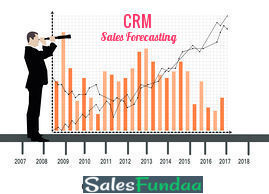
Do the sales forecast for your small business provide an accurate picture of stark reality, but still encourage growth?
With the possibility of higher profits on the table, no business owner should
be content with a sales forecasting strategy that under-delivers.
Salesfundaa CRM for can empower SME’s who may
see a visible 15% reduction in inventory, and a 2% increase in revenue.
A sales forecast ideally attempts to identify
when, where, and how your customers buy your product. Smart sales leaders recognise that
forecasting and strategy are related, yet independent of one another. An
effective sales strategy can give you important insights into your forecasting
efforts, and accurate forecasts can help you make wise decisions about
improving your strategy. Still, a great
forecast doesn’t automatically precipitate a sound sales strategy, and vice
versa.
As you refine your findings and take note of gaps, and successes, use
these results to change specific parts of your sales strategy. But, always remember that a sales strategy
exists to move customers through the pipeline, and deliver value.
For many SME’s, where resources are limited and cash flow is king, improved forecasting can prove a significant boon to the future prospects of the company. Here are key points to remember while doing sales forcasting for productive strategies:
1.Consult
all departments
It is essential to
consult all departments to make an effective forecast for future projections.
Representatives of each department should be a part and contributor to
this. This way different people who
understand different sets of data can give important input that some one else
might miss and may be a vital for analysis.
This kind of teamwork encourages buy-in-essential and can have an
immediate effect on company performance and strategy.
2. keep an eye on changing trends
Using past performance data to predict the
present is the cornerstone of most sales forecast strategies. However, business
realities, such as shifts in customer circumstances or industry developments,
can change in an instant. So, you need to be ready to adapt at short notice if
the environment is telling you to.
3.Set
regular forecasting sessions
Analysis and
evaluation is an important process to achieve set goals. As change is inevitable. It’s best to allocate regular times for the forecasting process. It’s a good exercise to monitor change and
allows you to prepare to deal with it.
But care should be taken to strike the correct balance between what is
humanly correct to deal with change. It’s
possible to become too consumed with forecasting. This can turn useful points of data into a
jumble of numbers with no clear through line.
4.Only include opportunities that have
feasible next steps
Look at the
possibility of every sales projection to be
opportunity. Don’t let
speculation disrupt this process of forcasting. You are at the risk of handicapping your
organisation by not considering these projections as valid opportunities. Also work out the possible next step.
5. Use technology to analyse trends
You need a clear and evolving view of trends
impacting your organisation, and whether they’re expected to continue in the coming
quarters and years. Observing high-level
trends is difficult when sorting through data manually, as new data sets can
push others out of mind and inhibit pattern recognition. Thankfully, you can rely on Salesfundaa CRM for Sales
forecasting- a technological break
through that can take the manual labour out of this process.
6.
Learn from incorrect sales projections
Learn from your incorrect projections , use them to constantly
refine your methods and improve your accuracy in future.
7. Understand your customers
Understanding customer
segments and buyer behaviour is an important part of forecasting accurately. You can manipulate your forecasts to say
whatever you want, but your revenue numbers only move when your customers make
very specific decisions, and take action. Learning what drives customers to act at
various touch points in their purchasing journey, will assist in painting an
accurate picture. This insight also helps mold the customer
personas your sales and marketing teams rely on.
Call SalesFundaa on
9235 35 35 35 for more solutions or you
can leave your comments in the box below.